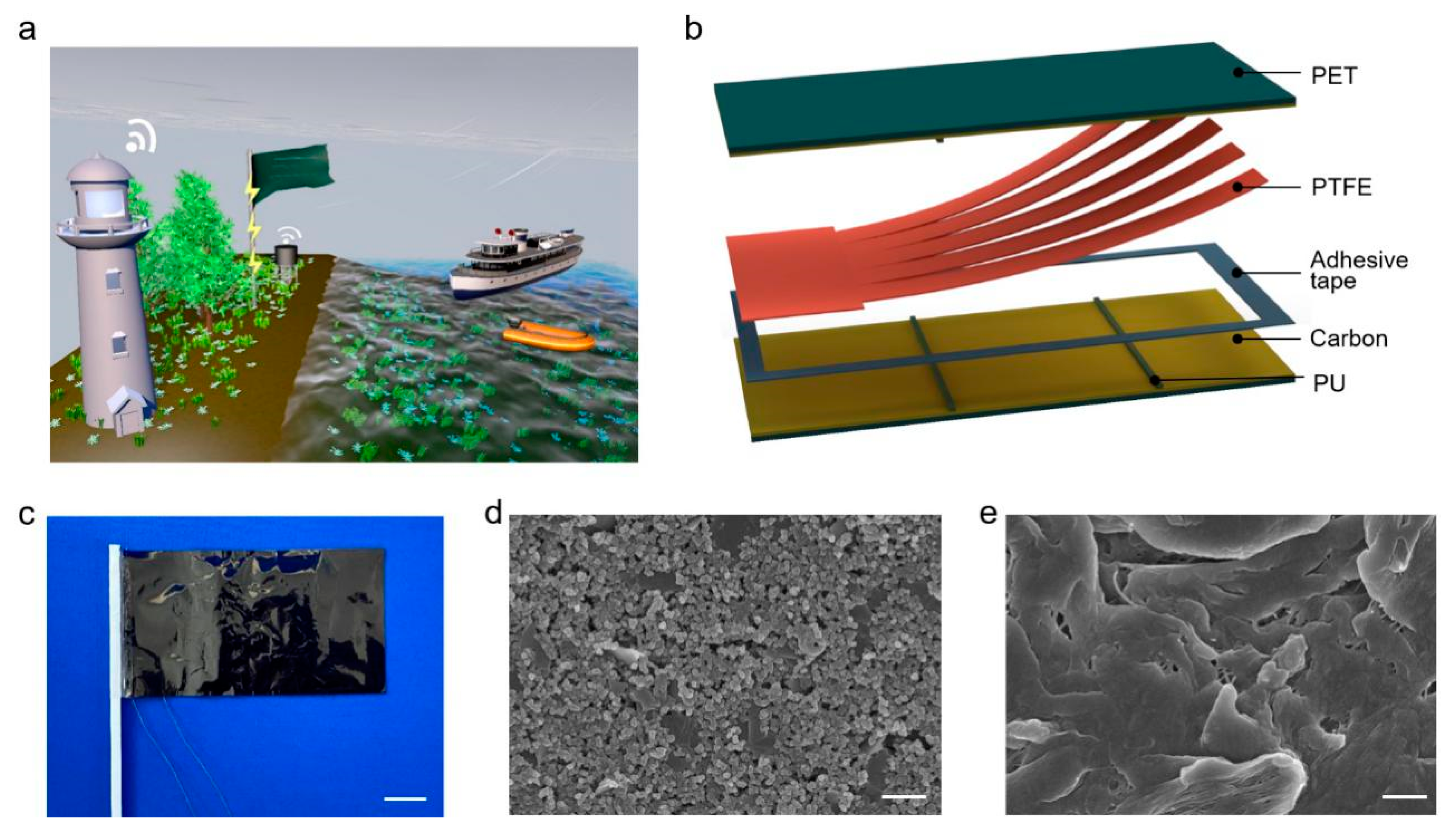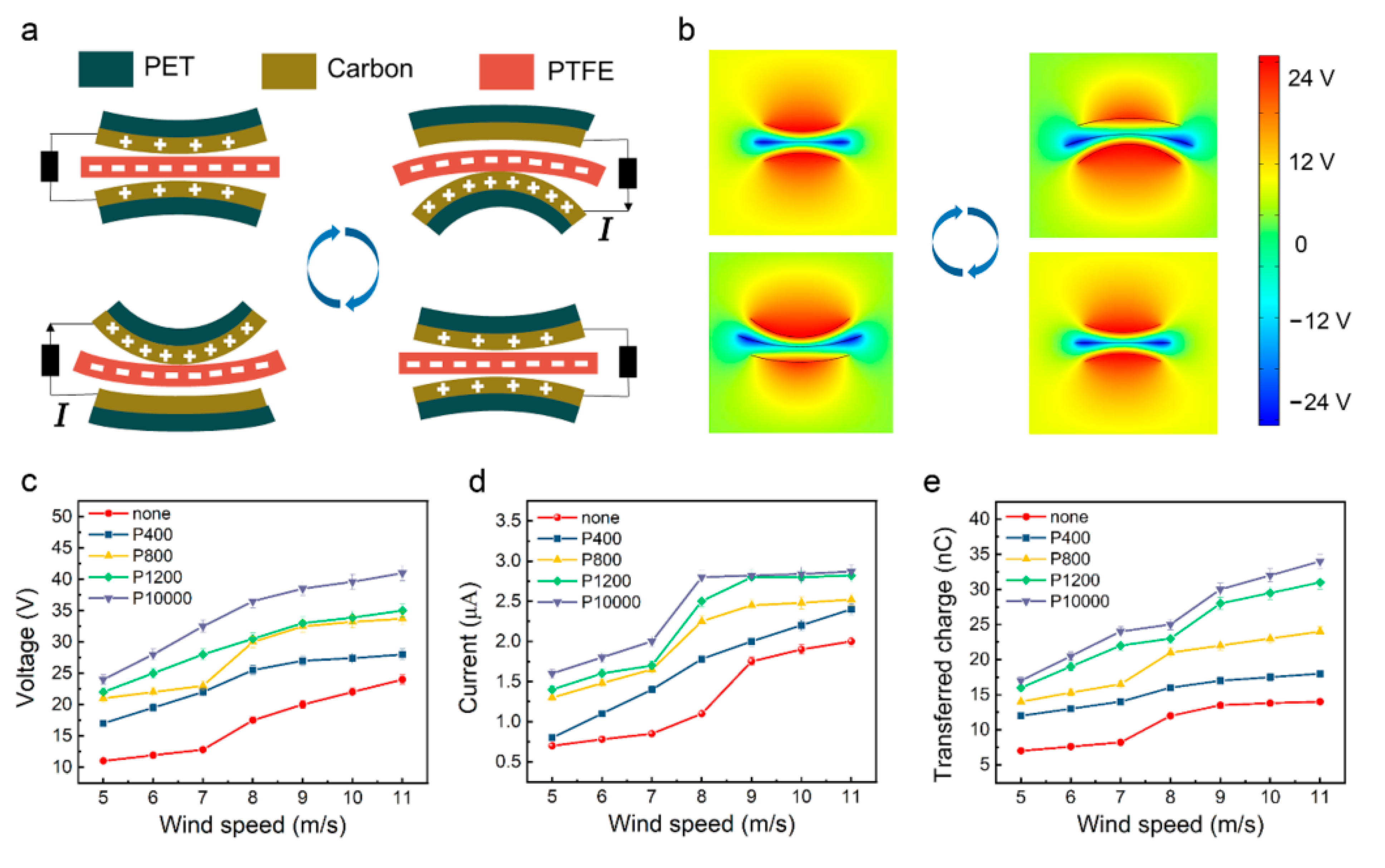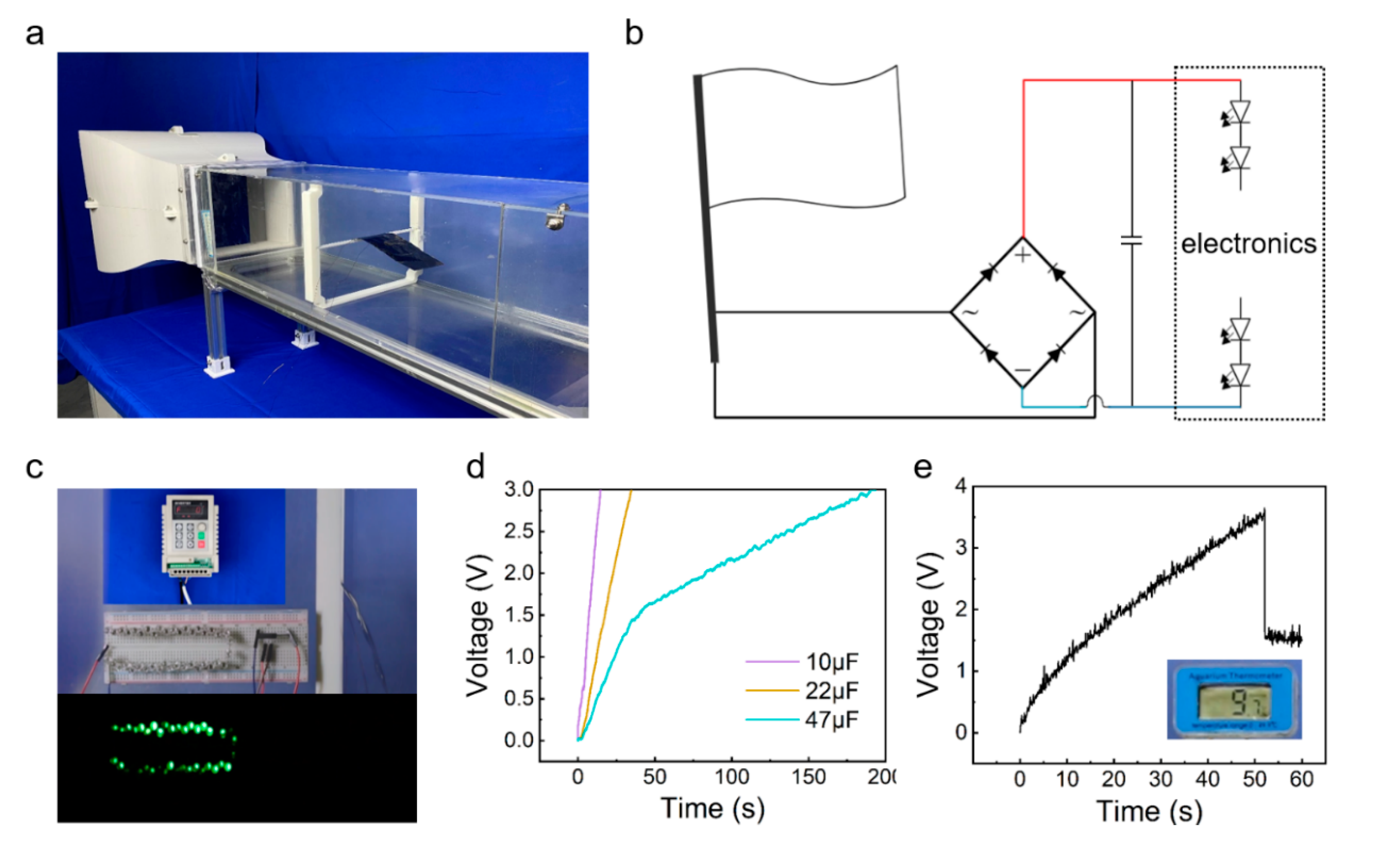A High-Performance Flag-Type Triboelectric Nanogenerator for Scavenging Wind Energy toward Self-Powered IoTs
Abstract
:1. Introduction
2. Materials and Methods
3. Results and Discussion
4. Conclusions
Supplementary Materials
Author Contributions
Funding
Conflicts of Interest
References
- Wang, Z.L. Entropy Theory of Distributed Energy for Internet of Things. Nano Energy 2019, 58, 669–672. [Google Scholar] [CrossRef]
- Ahmed, A.; Hassan, I.; El-Kady, M.F.; Radhi, A.; Jeong, C.K.; Selvaganapathy, P.R.; Zu, J.; Ren, S.; Wang, Q.; Kaner, R.B. Integrated Triboelectric Nanogenerators in the Era of the Internet of Things. Adv. Sci. 2019, 6, 1802230. [Google Scholar] [CrossRef] [Green Version]
- Zhao, T.; Xu, M.; Xiao, X.; Ma, Y.; Li, Z.; Wang, Z.L. Recent progress in blue energy harvesting for powering distributed sensors in ocean. Nano Energy 2021, 88, 106199. [Google Scholar] [CrossRef]
- Wang, Y.; Liu, X.; Wang, Y.; Wang, H.; Wang, H.; Zhang, S.L.; Zhao, T.; Xu, M.; Wang, Z.L. Flexible seaweed-like triboelectric nanogenerator as a wave energy harvester powering marine internet of things. ACS Nano 2021, 15, 15700–15709. [Google Scholar] [CrossRef] [PubMed]
- Espinosa, N.; Hosel, M.; Angmo, D.; Krebs, F.C. Solar Cells with One-day Energy Payback for the Factories of the Future. Energy Environ. Sci. 2012, 5, 5117–5132. [Google Scholar] [CrossRef]
- Abdullah, A.M.; Flores, A.; Chowdhury, A.R.; Li, J.; Mao, Y.; Uddin, M.J. Synthesis and Fabrication of Self-Sustainable TriboeLectric Energy Case for Powering Smart Electronic Devices. Nano Energy 2020, 73, 104774. [Google Scholar] [CrossRef]
- Dresselhaus, M.S.; Thomas, I.L. Alternative Energy Technologies. Nature 2001, 414, 332–337. [Google Scholar] [CrossRef]
- Yoon, H.J.; Ryu, H.; Kim, S.W. Sustainable Powering Triboelectric Nanogenerators: Approaches and the Path towards Efficient Use. Nano Energy 2018, 51, 270–285. [Google Scholar] [CrossRef]
- Zhang, Q.; Zhang, Z.; Liang, Q.J.; Gao, F.F.; Yi, F.; Ma, M.Y.; Liao, Q.L.; Kang, Z.; Zhang, Y. Green Hybrid Power System Based on Triboelectric Nanogenerator for Wearable/Portable Electronics. Nano Energy 2019, 55, 151–163. [Google Scholar] [CrossRef]
- Indira, S.S.; Vaithilingam, C.A.; Oruganti, K.S.P.; Mohd, F.; Rahman, S. Nanogenerators as a Sustainable Power Source: State of Art, Applications, and Challenges. Nanomaterials 2019, 9, 773. [Google Scholar] [CrossRef] [Green Version]
- Zhao, X.; Chen, B.; Wei, G.D.; Wu, J.M.; Han, W.; Yang, Y. Polyimide/Graphene Nanocomposite Foam-Based Wind-Driven Triboelectric Nanogenerator for Self-Powered Pressure Sensor. Adv. Mater. Technol. 2019, 4, 1800723. [Google Scholar] [CrossRef]
- Gong, Y.; Yang, Z.B.; Shan, X.B.; Sun, Y.B.; Xie, T.; Zi, Y.L. Capturing Flow Energy from Ocean and Wind. Energies 2019, 12, 2184. [Google Scholar] [CrossRef] [Green Version]
- Qian, J.G.; Jing, X.J. Wind-Driven Hybridized Triboelectric-Electromagnetic Nanogenerator and Solar Cell as a Sustainable Power Unit for Self-Powered Natural Disaster Monitoring Sensor Networks. Nano Energy 2018, 52, 78–87. [Google Scholar] [CrossRef]
- Chen, B.; Yang, Y.; Wang, Z.L. Scavenging Wind Energy by Triboelectric Nanogenerators. Adv. Energy Mater. 2018, 8, 1702649. [Google Scholar] [CrossRef]
- Seol, M.-L.; Woo, J.-H.; Jeon, S.-B.; Kim, D.; Park, S.-J.; Hur, J.; Choi, Y.-K. Vertically Stacked Thin Triboelectric Nanogenerator for Wind Energy Harvesting. Nano Energy 2015, 14, 201–208. [Google Scholar] [CrossRef]
- Wendler, R.; Calderón Muñoz, W.; LeBoeuf, R. Energy-Based Iteration Scheme of the Double-Multiple Streamtube Model in Vertical-Axis Wind Turbines. Acta. Mech. 2016, 227, 3295–3303. [Google Scholar] [CrossRef]
- Zhou, A.; Yu, D.; Wu, X.; Liu, J.; Li, R. Research on Intelligent Fault Diagnosis for Large-Scale Wind Turbines Based on Ontology. China Mech. Eng. 2012, 23, 2075–2080. [Google Scholar]
- Wang, X.; Pan, C.L.; Liu, Y.B.; Feng, Z.H.J.S.; Physical, A.A. Electromagnetic Resonant Cavity Wind Energy Harvester with Optimized Reed Design and Effective Magnetic Loop. Sens. Actuator A Phys. 2014, 205, 63–71. [Google Scholar] [CrossRef]
- Lu, Z.; Wen, Q.; He, X.; Wen, Z. A Flutter-Based Electromagnetic Wind Energy Harvester: Theory and Experiments. Appl. Sci. 2019, 9, 4823. [Google Scholar] [CrossRef] [Green Version]
- Shi, T.; Hu, G.; Zou, L.; Song, J.; Kwok, K. Performance of an Omnidirectional Piezoelectric Wind Energy Harvester. Wind Energy 2021, 24, 1167–1179. [Google Scholar] [CrossRef]
- Hu, G.; Wang, J.; Su, Z.; Li, G.; Peng, H.; Kwok, K. Performance Evaluation of Twin Piezoelectric Wind Energy Harvesters Under Mutual Interference. Appl. Phys. Lett. 2019, 115, 073901. [Google Scholar] [CrossRef]
- Wang, Z.L. Triboelectric Nanogenerators as New Energy Technology and Self-Powered Sensors—Principles, Problems and Perspectives. Faraday Discuss. 2014, 176, 447–458. [Google Scholar] [CrossRef] [PubMed]
- Wang, Z.L. Triboelectric Nanogenerators as New Energy Technology for Self-Powered Systems and as Active Mechanical and Chemical Sensors. ACS Nano 2013, 7, 9533–9557. [Google Scholar] [CrossRef] [PubMed]
- Zou, Y.; Xu, J.; Chen, K.; Chen, J. Advances in Nanostructures for High-Performance Triboelectric Nanogenerators. Adv. Mater. Technol. 2021, 6, 2000916. [Google Scholar] [CrossRef]
- Xu, M.Y.; Zhao, T.C.; Wang, C.; Zhang, S.L.; Li, Z.; Pan, X.X.; Wang, Z.L. High Power Density Tower-Like Triboelectric Nanogenerator for Harvesting Arbitrary Directional Water Wave Energy. ACS Nano 2019, 13, 1932–1939. [Google Scholar] [CrossRef]
- Xu, M.Y.; Wang, P.H.; Wang, Y.C.; Zhang, S.L.; Wang, A.C.; Zhang, C.L.; Wang, Z.J.; Pan, X.X.; Wang, Z.L. A Soft and Robust Spring Based Triboelectric Nanogenerator for Harvesting Arbitrary Directional Vibration Energy and Self-Powered Vibration Sensing. Adv. Energy Mater. 2018, 8, 17024. [Google Scholar] [CrossRef]
- Yang, Y.; Zhu, G.; Zhang, H.; Chen, J.; Zhong, X.; Lin, Z.H.; Su, Y.; Bai, P.; Wen, X.; Wang, Z.L. Triboelectric Nanogenerator for Harvesting Wind Energy and as Self-Powered Wind Vector Sensor System. ACS Nano 2013, 7, 9461–9468. [Google Scholar] [CrossRef]
- Li, J.; Chen, J.; Guo, H.J.E. Triboelectric Nanogenerators for Harvesting Wind Energy: Recent Advances and Future Perspectives. Energies 2021, 14, 6949. [Google Scholar] [CrossRef]
- Quan, Z.; Han, C.B.; Jiang, T.; Wang, Z.L. Robust Thin Films-Based Triboelectric Nanogenerator Arrays for Harvesting Bidirectional Wind Energy. Adv. Energy Mater. 2016, 6, 15017. [Google Scholar] [CrossRef]
- Zhao, C.; Liu, D.; Wang, Y.; Hu, Z.; Zhang, Q.; Zhang, Z.; Wang, H.; Du, T.; Zou, Y.; Yuan, H.; et al. Highly-Stretchable Rope-Like Triboelectric Nanogenerator for Self-Powered Monitoring in Marine Structures. Nano Energy 2022, 94, 106926. [Google Scholar] [CrossRef]
- Xu, P.; Wang, X.; Wang, S.; Chen, T.; Liu, J.; Zheng, J.; Li, W.; Xu, M.; Tao, J.; Xie, G. A Triboelectric-Based Artificial Whisker for Reactive Obstacle Avoidance and Local Mapping. Research 2021, 10, 9864967. [Google Scholar] [CrossRef]
- Wang, Y.; Liu, X.; Chen, T.; Wang, H.; Zhu, C.; Yu, H.; Song, L.; Pan, X.; Mi, J.; Lee, C.; et al. An Underwater Flag-Like Triboelectric Nanogenerator for Harvesting Ocean Current Energy Under Extremely Low Velocity Condition. Nano Energy 2021, 90, 106503. [Google Scholar] [CrossRef]
- Wang, H.; Fan, Z.; Zhao, T.; Dong, J.; Wang, S.; Wang, Y.; Xiao, X.; Liu, C.; Pan, X.; Zhao, Y.; et al. Sandwich-Like Triboelectric Nanogenerators Integrated Self-Powered Buoy for Navigation Safety. Nano Energy 2021, 84, 105920. [Google Scholar] [CrossRef]
- Zhao, Z.; Pu, X.; Du, C.; Li, L.; Jiang, C.; Hu, W.; Wang, Z.L. Freestanding Flag-Type Triboelectric Nanogenerator for Harvesting High-Altitude Wind Energy from Arbitrary Directions. ACS Nano 2016, 10, 1780–1787. [Google Scholar] [CrossRef] [PubMed]
- Nguyen, V.; Yang, R. Effect of Humidity and Pressure on the Triboelectric Nanogenerator. Nano Energy 2013, 2, 604–608. [Google Scholar] [CrossRef]
- Chang, T.H.; Peng, Y.W.; Chen, C.H.; Chang, T.W.; Wu, J.M.; Hwang, J.C.; Gan, J.Y.; Lin, Z.H. Protein-Based Contact Electrification and Its Uses for Mechanical Energy Harvesting and Humidity Detecting. Nano Energy 2016, 21, 238–246. [Google Scholar] [CrossRef]
- Phan, T.K.; Wang, S.; Wang, Y.; Wang, H.; Xiao, X.; Pan, X.; Xu, M.; Mi, J. A Self-Powered and Low Pressure Loss Gas FlowMeter Based on Fluid-Elastic Flutter Driven Triboelectric Nanogenerator. Sensors 2020, 20, 729. [Google Scholar] [CrossRef] [Green Version]
- Wang, Y.; Yang, E.; Chen, T.; Wang, J.; Hu, Z.; Mi, J.; Pan, X.; Xu, M. A Novel Humidity Resisting and Wind Direction Adapting Flag-Type Triboelectric Nanogenerator for Wind Energy Harvesting and Speed Sensing. Nano Energy 2020, 78, 105279. [Google Scholar] [CrossRef]
- Zhao, Z.; Wei, B.; Wang, Y.; Huang, X.; Li, B.; Lin, F.; Ma, L.; Zhang, Q.; Zou, Y.; Yang, F.; et al. An Array of Flag-Type Triboelectric Nanogenerators for Harvesting Wind Energy. Nanomaterials 2022, 12, 721. [Google Scholar] [CrossRef]
- Su, Y.; Xie, G.; Xie, T.; Zhang, H.; Ye, Z.; Jing, Q.; Tai, H.; Du, X.; Jiang, Y. Wind energy harvesting and self-powered flow rate sensor enabled by contact electrification. J. Phys. D Appl. Phys. 2016, 49, 215601. [Google Scholar] [CrossRef]
- Ye, C.; Dong, K.; An, J.; Yi, J.; Peng, X.; Ning, C.; Wang, Z.L. A triboelectric–electromagnetic hybrid nanogenerator with broadband working range for wind energy harvesting and a self-powered wind speed sensor. ACS Energy Lett. 2021, 6, 1443–1452. [Google Scholar] [CrossRef]
- Ma, M.; Zhang, Z.; Liao, Q.; Zhang, G.; Gao, F.; Zhao, X.; Zhang, Q.; Xun, X.; Zhang, Z.; Zhang, Y. Integrated hybrid nanogenerator for gas energy recycle and purification. Nano Energy 2017, 39, 524–531. [Google Scholar] [CrossRef]
- Wang, S.; Mu, X.; Yang, Y.; Sun, C.; Gu, A.Y.; Wang, Z.L. Flow-driven triboelectric generator for directly powering a wireless sensor node. Adv. Mater. 2015, 27, 240–248. [Google Scholar] [CrossRef] [PubMed]
- Guo, H.; He, X.; Zhong, J.; Zhong, Q.; Leng, Q.; Hu, C.; Chen, J.; Tian, L.; Xi, Y.; Zhou, J. A nanogenerator for harvesting airflow energy and light energy. J. Mater. Chem. A 2014, 2, 2079–2087. [Google Scholar] [CrossRef]
- Zheng, H.; Zi, Y.; He, X.; Guo, H.; Lai, Y.-C.; Wang, J.; Zhang, S.L.; Wu, C.; Cheng, G.; Wang, Z.L. Concurrent harvesting of ambient energy by hybrid nanogenerators for wearable self-powered systems and active remote sensing. ACS Appl. Mater. Interfaces 2018, 10, 14708–14715. [Google Scholar] [CrossRef]
- Wang, S.; Wang, X.; Wang, Z.L.; Yang, Y. Efficient scavenging of solar and wind energies in a smart city. ACS Nano 2016, 10, 5696–5700. [Google Scholar] [CrossRef]
- Wang, S.; Mu, X.; Wang, X.; Gu, A.Y.; Wang, Z.L.; Yang, Y. Elasto-aerodynamics-driven triboelectric nanogenerator for scavenging air-flow energy. ACS Nano 2015, 9, 9554–9563. [Google Scholar] [CrossRef]




Publisher’s Note: MDPI stays neutral with regard to jurisdictional claims in published maps and institutional affiliations. |
© 2022 by the authors. Licensee MDPI, Basel, Switzerland. This article is an open access article distributed under the terms and conditions of the Creative Commons Attribution (CC BY) license (https://creativecommons.org/licenses/by/4.0/).
Share and Cite
Zou, Y.; Sun, M.; Yan, F.; Du, T.; Xi, Z.; Li, F.; Zhu, C.; Wang, H.; Zhao, J.; Sun, P.; et al. A High-Performance Flag-Type Triboelectric Nanogenerator for Scavenging Wind Energy toward Self-Powered IoTs. Materials 2022, 15, 3696. https://doi.org/10.3390/ma15103696
Zou Y, Sun M, Yan F, Du T, Xi Z, Li F, Zhu C, Wang H, Zhao J, Sun P, et al. A High-Performance Flag-Type Triboelectric Nanogenerator for Scavenging Wind Energy toward Self-Powered IoTs. Materials. 2022; 15(10):3696. https://doi.org/10.3390/ma15103696
Chicago/Turabian StyleZou, Yongjiu, Minzheng Sun, Fei Yan, Taili Du, Ziyue Xi, Fangming Li, Chuanqing Zhu, Hao Wang, Junhao Zhao, Peiting Sun, and et al. 2022. "A High-Performance Flag-Type Triboelectric Nanogenerator for Scavenging Wind Energy toward Self-Powered IoTs" Materials 15, no. 10: 3696. https://doi.org/10.3390/ma15103696
APA StyleZou, Y., Sun, M., Yan, F., Du, T., Xi, Z., Li, F., Zhu, C., Wang, H., Zhao, J., Sun, P., & Xu, M. (2022). A High-Performance Flag-Type Triboelectric Nanogenerator for Scavenging Wind Energy toward Self-Powered IoTs. Materials, 15(10), 3696. https://doi.org/10.3390/ma15103696








